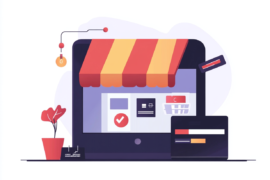This article may contain references to products or services from one or more of our advertisers or partners. We may receive compensation when you click on links to those products or services. Nonetheless, our opinions are our own.
- Introduction:
- Start treating your e-commerce store like a real business:
- Choose products that scale and offer strong profit margins:
- Master digital marketing and customer acquisition strategies:
- Build a strong and memorable brand identity:
- Create systems to automate repetitive tasks and save time:
- Focus on customer retention and repeat purchases:
- Know when to outsource and build a support team:
- Use data and analytics to drive every business decision:
- Develop a unique selling proposition that sets you apart:
- Refine your website for high conversions and user experience:
- Use content creation to build trust and long-term traffic:
- Diversify your revenue streams to reduce risk:
- Invest in personal development and entrepreneurial skills:
- Conclusion:
- Recommended Reads
Introduction:
E-commerce has opened the doors for everyday people to build real businesses from scratch. Whether you’re selling handmade products, dropshipping trending items, or launching your own private label brand, the opportunity is bigger than ever. Many people begin their journey by working on their online store during evenings or weekends, testing the waters to see if it’s worth pursuing further. But for those who are serious, that side hustle can evolve into a primary income stream—and even grow beyond what you imagined possible.
However, this shift does not happen without a mindset change. It requires treating your store as a legitimate business, not a part-time hobby. The goal is to build consistency in revenue, improve margins, automate processes, and serve your customers in ways that lead to repeat business. You also need to embrace long-term thinking, since quick wins are nice, but sustainable growth comes from steady effort and improvement.
In this guide, we’ll break down everything you need to move from a side hustle mindset to becoming a full-time e-commerce entrepreneur. You’ll learn how to refine your product offering, build a strong brand, create repeatable systems, market effectively, and make data-driven decisions. Whether you’re earning your first $500 or you’ve already had a $10,000 month, these strategies will help you scale up and secure a more stable, long-term income. Let’s get started.
Start treating your e-commerce store like a real business:
The first and most important step in turning your side hustle into a reliable income stream is changing the way you view your store. As long as you treat it like a casual project, it will continue to produce casual results. Making the shift from part-time seller to full-time business owner starts with structure and intentional planning.
You should begin by defining clear business goals. Set monthly revenue targets, identify how much profit you need to cover your expenses, and calculate how many sales that requires. Establish a business budget and allocate spending toward inventory, tools, marketing, and growth initiatives. Once you start tracking your income and expenses seriously, you’ll notice how many areas can be optimized or improved.
- Tiffany Payne, Head of Content at PharmacyOnline.co.uk
Another important shift is developing a routine. Side hustlers often work on their store “whenever they have time,” which leads to inconsistent progress. Instead, create a regular schedule where you dedicate focused hours to operations, marketing, fulfillment, and learning. Treat it like a job before it becomes your job.
Here are a few key steps to professionalize your store:
- Register your business legally and obtain any necessary permits or tax IDs.
- Create a business bank account and separate your finances.
- Invest in quality tools for email marketing, analytics, and customer support.
- Track metrics weekly to monitor growth and identify weak points.
- Draft a long-term plan that outlines your goals and how to reach them.
When you start thinking like a CEO instead of a side hustler, your actions become more strategic. That mindset alone will push your store closer to full-time income territory.
How Automation and AI Can Transform Your E-Commerce Side Hustle:
The fastest way to scale your e-commerce side hustle is by leveraging automation tools and AI to free up your time. At Teacherbot, we’ve seen firsthand how educators and entrepreneurs can use AI-powered solutions to handle repetitive tasks, allowing them to focus on growth, content creation, and customer experience — the foundations of turning side hustles into sustainable businesses.
- Katie Hasselstorm, Founder of Teacher Bot
Choose products that scale and offer strong profit margins:
Many e-commerce businesses fail to grow simply because they pick the wrong products. If you want to turn your store into a dependable income stream, you need to sell products that people want, that offer enough profit to grow with, and that are scalable in terms of production and fulfillment. This means avoiding super low-ticket items with tight margins unless you have a plan for high-volume sales.
Instead, look for products with:
- A strong niche appeal or passionate audience
- Repeat purchase potential or upsell opportunities
- Affordable sourcing and shipping costs
- Pricing power that allows for at least 30–50% profit margins
These kinds of products allow you to invest in marketing, scale your ad spend, and hire help down the line. For example, instead of selling trendy $5 gadgets with tiny margins, consider mid-tier products like $40–$100 wellness accessories, kitchen tools, or fashion items that people value and share with others.
- Andy Slack, Founder of Health Nutrition
Also, think about your ability to scale operations. Can you fulfill orders easily? Can your supplier handle 100x growth if needed? Can the product be stored and shipped efficiently? These logistics impact how fast and how far you can scale.
Here are questions to ask before locking in a product:
- Is this product in demand or solving a problem?
- Can I make a healthy margin even after marketing and shipping?
- Will customers come back for more?
- Is it legally and ethically safe to sell (no trademark or safety issues)?
- Can I build a brand around this?
Choosing scalable products early can mean the difference between hustling for years and building a business that sustains you full-time.
Master digital marketing and customer acquisition strategies:
Marketing is the engine that drives your sales, and if you don’t know how to consistently attract the right traffic, you’ll always struggle to scale. As an e-commerce entrepreneur, your job is not just to have a great product—it’s to make sure people find and buy it. That means learning how to attract visitors, build trust, and convert them into paying customers.
Start with the basics of customer acquisition:
- Who is your ideal customer?
- Where do they spend time online?
- What problems or emotions drive their purchase decisions?
- What kind of messaging do they respond to?
From there, you can build marketing strategies tailored to your audience. These might include paid ads, content creation, SEO, social media engagement, influencer marketing, and email nurturing. The key is not just to get traffic, but to get targeted traffic—people most likely to buy your product.
- Bradley Fry, Owner of Custom Pins
Top digital marketing channels for e-commerce:
- Facebook and Instagram Ads: Great for visual products and broad targeting.
- Google Shopping and Search Ads: Excellent for high-intent traffic.
- Email Marketing: Crucial for nurturing leads and driving repeat purchases.
- Content Marketing: Blog posts, tutorials, or guides that educate and lead to sales.
- Influencer Collaborations: Help reach warm audiences fast.
Always be testing. Test ad creatives, email subject lines, landing page headlines, and CTA buttons. The more data you collect, the better decisions you can make. Successful stores are built not just on great marketing—but measurable marketing that improves over time.
Build a strong and memorable brand identity:
Your brand is more than your logo. It’s how your customers perceive your business, how they feel when interacting with you, and what they remember long after their first purchase. To move beyond being “just another store,” you need a brand that connects emotionally with your audience and builds trust.
Start by defining your brand’s core values and message. Ask yourself: Why does your store exist? Who is it serving? What problem does it solve or what lifestyle does it support? When you build your store around those ideas, your messaging becomes more authentic and effective.
Visual branding plays a major role too. Consistent color schemes, fonts, photo styles, and packaging all contribute to the customer experience. But just as important is your tone of voice—how you write product descriptions, emails, or social media posts. Are you casual, luxury, playful, or educational? Stick to that tone across every channel.
- Magnus Larsen, Head of Marketing at Forbrukerguiden
A memorable brand will:
- Make your store recognizable and trustworthy
- Increase customer loyalty and word-of-mouth marketing
- Help you charge premium prices over generic competitors
You can also strengthen your brand by:
- Adding a strong About Us page with your story
- Showcasing social proof like testimonials and reviews
- Including behind-the-scenes content (photos or videos)
- Delivering an exceptional unboxing experience
People don’t just buy products—they buy from brands they connect with. If you can create that emotional tie, your customers will not only return—they’ll become your best marketers.
Create systems to automate repetitive tasks and save time:
As your business grows, you’ll quickly realize that doing everything manually will not only burn you out but also slow down your progress. Every repetitive task—sending emails, tracking inventory, posting on social media—can be automated or streamlined using tools and systems. The goal is to free up your time so you can focus on high-impact activities like strategy, growth, and customer experience.
- Erick Recors, Founder & CEO of Fullbloom Greenhouse
Start by listing all the daily, weekly, and monthly tasks you perform. Then identify which ones repeat regularly and don’t require your direct input. These are your top automation opportunities. The good news? Most e-commerce platforms already integrate with automation tools that are simple to set up.
Here are areas of your business that should be automated:
- Email Marketing: Set up automated flows for abandoned cart reminders, post-purchase follow-ups, and welcome sequences.
- Order Fulfillment: Use print-on-demand services or third-party logistics (3PL) to handle packing and shipping.
- Social Media: Schedule posts in advance with tools like Buffer or Later.
- Inventory Management: Use software that syncs with your supplier or warehouse in real time.
- Customer Support: Implement chatbots or AI-powered FAQs to answer common questions 24/7.
When everything runs on a system, you reduce errors and avoid decision fatigue. You can also scale operations much more easily. Imagine handling 1,000 orders per week without having to touch every email or track every shipment manually—that’s the power of automation.
Also, automation does not mean removing the human element. You can still personalize your brand while letting systems handle the grunt work. It’s about working smarter, not harder. The less time you spend doing repetitive tasks, the more time you have to focus on strategic growth and improving your customer journey.
Focus on customer retention and repeat purchases:
While most e-commerce beginners obsess over getting new customers, the real money is in retaining the ones you already have. Acquiring new buyers costs 5–7x more than keeping existing ones, and repeat customers are more likely to spend more per order and refer your brand to others. So if you’re serious about building a full-time income, your retention strategy should be just as strong as your acquisition plan.
Start by creating an unforgettable first impression. Fast shipping, quality packaging, and helpful post-purchase communication make your customers feel valued. After that, stay connected. A strong email list and consistent social media presence keep your brand top of mind and encourage future purchases.
- Lindsay Leaf, Marketing Director at Go Live Outdoor
Here are proven strategies to increase repeat sales:
- Loyalty Programs: Reward customers for every purchase and offer exclusive discounts for returning shoppers.
- Replenishment Reminders: Send emails reminding customers to reorder consumable products.
- Cross-Selling and Upselling: Recommend complementary items after the initial purchase.
- Exclusive Offers: Give returning customers early access to new launches or special sales.
- Surprise and Delight: Occasionally throw in a freebie, thank-you note, or discount code to create a positive memory.
Also, ask for feedback regularly. Not only does it show that you care, but it gives you insights to improve. A happy customer is more likely to return—and more likely to become a brand advocate.
Retention is the key to stability. If you can consistently generate 40–60% of your monthly sales from repeat customers, you’re no longer just chasing growth—you’re building a business that lasts.
Know when to outsource and build a support team:
Trying to do everything yourself might save you money at first, but eventually it will limit your growth and drain your energy. Once your store starts gaining momentum, outsourcing becomes one of the smartest ways to scale. Delegating repetitive or specialized tasks frees you up to focus on strategy, partnerships, and innovation.
Start with tasks that are time-consuming or outside your skill set. This could include product photography, social media management, customer support, ad creation, or bookkeeping. Hiring freelancers or agencies for these tasks is often more affordable than bringing on full-time employees, and it gives you flexibility as your business evolves.
- Andy Fryer, Co-Founder of Easy Signs
Here are key roles to consider outsourcing early:
- Virtual Assistant: Help with admin work, order processing, and email replies.
- Customer Service Rep: Manage inquiries, complaints, and post-sale support.
- Marketing Specialist: Run paid ads or handle influencer outreach.
- Graphic Designer: Create visuals for your website, ads, and social media.
- Product Sourcing Manager: If you sell private label or wholesale, this role can help scale sourcing efforts.
Eventually, you may consider building a core team—either remote or in-house. Hiring slowly and strategically ensures you bring on people who understand your brand and mission.
When you let go of the idea that you have to do everything alone, your business can grow faster—and with less stress. The best founders know their strengths and build teams to handle the rest. That’s how you move from hustle to real, scalable business ownership.
Use data and analytics to drive every business decision:
Running a business without tracking data is like driving blindfolded—you might move forward, but you’ll crash eventually. Data is the compass that tells you what’s working, what’s wasting money, and where the next opportunity lies. If you want to build a full-time income, you need to know your numbers and use them to guide your decisions.
Start by setting up Google Analytics and ensuring that your e-commerce platform is tracking important KPIs (key performance indicators). Monitor your traffic sources, conversion rates, bounce rates, average order value, and customer lifetime value. These metrics will give you a snapshot of your business’s health.
- John Beebe, CEO at Classic Car Deals
Important metrics to track regularly:
- Conversion Rate: What percentage of visitors are buying?
- Cost Per Acquisition (CPA): How much are you spending to get each customer?
- Return on Ad Spend (ROAS): Are your ads making you money?
- Customer Lifetime Value (CLTV): How much is a customer worth over time?
- Email Open and Click Rates: Are your campaigns effective?
Use this data to double down on what’s working and cut what’s not. If Instagram ads are driving high conversions but TikTok isn’t, shift your budget accordingly. If certain products have a higher return rate, investigate why.
Analytics also help with inventory planning, marketing timing, and customer experience. The more you rely on hard numbers over guesswork, the more confidently you can scale.
Most importantly, make reviewing data a weekly habit—not something you do once a month. When you make data a part of your everyday decision-making, growth becomes predictable and far less stressful.
Develop a unique selling proposition that sets you apart:
In today’s saturated e-commerce landscape, having a product to sell is not enough. You need a unique selling proposition (USP) that clearly tells potential customers why they should choose your store over all the others. A good USP goes beyond price or convenience—it connects with people on an emotional level or solves a specific problem in a way others don’t.
- Jose Gomez from Gold Silver Swap
Your USP should answer this one question: Why should someone buy from me instead of Amazon or a competitor? It could be anything from exceptional customer service, eco-friendly packaging, exclusive handmade designs, or lightning-fast shipping. Whatever it is, it must be specific, memorable, and easy to communicate in your ads, homepage, product pages, and emails.
Ways to define and highlight your USP:
- Identify gaps in your competitors’ offerings (slow shipping, generic branding, poor support).
- Ask existing customers why they chose you.
- Focus on emotional benefits, not just features (e.g. “confidence,” “peace of mind,” “self-care”).
- Craft a one-sentence elevator pitch you can use across your website.
Once your USP is clear, it should be visible everywhere—your website banner, Instagram bio, packaging, and even your receipts. This consistency helps position your store as different, trustworthy, and valuable in the customer’s mind.
When done well, your USP turns browsers into buyers and occasional shoppers into long-term fans. It’s what gives your store meaning beyond products—and that’s what creates a sustainable business. Brands that last are the ones people remember, and a strong USP is the first step in making that happen.
Refine your website for high conversions and user experience:
Your website is the heart of your e-commerce business. No matter how great your ads are, if visitors land on a site that’s slow, confusing, or untrustworthy, they will not stick around. That’s why optimizing your website for conversion rate and user experience (UX) is one of the most powerful levers for growing income.
Start by simplifying your navigation. Visitors should immediately understand who you are, what you sell, and how to make a purchase. Your homepage should highlight your USP, feature your best-selling or most profitable items, and include clear calls to action.
- Alex Constantinou – MD at The Fitness Circle
Speed and mobile optimization are also crucial. Most e-commerce traffic comes from mobile devices, so your site must load quickly and be easy to browse on smaller screens. Use a responsive design and minimize clutter, popups, and heavy images.
Tips to improve your website’s conversion rate:
- Use high-quality product photos and videos from multiple angles.
- Include detailed product descriptions with size, features, and benefits.
- Add trust badges, reviews, and testimonials to product pages.
- Display clear shipping information, return policies, and contact details.
- Use tools like Hotjar or Crazy Egg to see where users drop off or get confused.
It’s also worth running A/B tests on key elements like headlines, buttons, and product page layouts. Even small tweaks (like changing your CTA from “Buy Now” to “Get Yours Today”) can lead to big improvements in conversions.
Ultimately, a clean, fast, and intuitive website builds trust. When customers enjoy their experience, they buy more, come back more often, and recommend your store to others. That’s the type of growth you want when building toward a full-time income.
Use content creation to build trust and long-term traffic:
Content is not just for bloggers—it’s a powerful tool for e-commerce brands that want to build long-term trust and organic traffic. Whether you’re publishing blog posts, shooting TikToks, writing emails, or creating product tutorials, content helps you educate your audience, answer questions, and build authority in your niche.
One of the biggest benefits of content is that it keeps working even when you’re not. A well-written blog post can drive Google traffic for years. A helpful YouTube video can bring in new customers every day. And a viral Instagram Reel can give your store instant exposure to thousands of new eyes.
Content types that work well for e-commerce:
- How-to guides related to your product (e.g. “How to Care for Leather Bags”)
- Product comparison videos or side-by-side reviews
- Behind-the-scenes content showing your process or packaging
- Customer stories or case studies
- Email newsletters with tips, inspiration, and special offers
To get the most out of your content, optimize it for SEO. Use keyword research tools like Ubersuggest or Ahrefs to find topics people are searching for, then structure your content to match. Add internal links to product pages and make it easy for visitors to explore your store from each piece of content.
Consistency is key. Posting once a month is fine if that’s all you can manage, as long as it’s regular and strategic. Over time, this content becomes a web of trust, helping customers find you organically and making your paid traffic more efficient.
The brands that win long term aren’t just loud—they’re helpful. Great content makes you both.
Diversify your revenue streams to reduce risk:
One of the biggest threats to your e-commerce business is dependency on a single revenue source. Whether it’s relying on one traffic channel (like Facebook ads), one product line, or one marketplace (like Etsy), too much concentration creates vulnerability. If that one stream dries up or changes, your income can take a big hit.
That’s why successful full-time e-commerce entrepreneurs diversify. They create multiple pathways for revenue, so their business is more stable, adaptable, and scalable. This doesn’t mean launching ten new products at once—but it does mean planning for variety as you grow.
Smart ways to diversify income in e-commerce:
- Expand your product line: Add variations, accessories, or seasonal products that appeal to the same audience.
- Offer digital products: Ebooks, guides, or courses work especially well for niche stores with educational angles.
- Introduce subscription services: Monthly boxes or reorder programs create predictable, recurring revenue.
- Sell on multiple platforms: Expand from your website to Amazon, Etsy, Walmart, or other relevant marketplaces.
- Run affiliate partnerships or collabs: Promote complementary products or partner with other creators to reach new audiences.
You can also consider monetizing your email list through partnerships or upsells, or launching a branded YouTube channel that earns ad revenue.
The more streams you develop over time, the safer your business becomes. If one channel dips, the others can keep things afloat. Diversification is not just about making more money—it’s about protecting what you’ve built and creating long-term peace of mind.
Invest in personal development and entrepreneurial skills:
Behind every successful e-commerce business is a founder who kept learning. The truth is, your store can only grow as much as you grow. The more skills you develop—marketing, leadership, copywriting, analytics—the better decisions you’ll make, and the faster you’ll adapt to change.
Treat personal development as part of your job. Dedicate a few hours each week to reading business books, listening to podcasts, taking online courses, or attending virtual workshops. Focus on the skills that directly impact your bottom line, but don’t ignore the soft skills like time management, negotiation, or emotional resilience.
- Adam Southall, Co-Founder of FixTheMusic
Here are key areas to invest in:
- Marketing and copywriting: Learn how to craft offers, write headlines, and run profitable ads.
- Analytics and finance: Understand your margins, cash flow, and customer lifetime value.
- Leadership: As your business grows, you’ll need to manage people and delegate tasks.
- Mindset and productivity: Stay focused, avoid burnout, and push through tough phases.
- Industry trends: Stay on top of changes in social media, e-commerce platforms, and customer expectations.
You don’t have to become an expert in everything, but knowing enough to make informed decisions makes you a stronger founder. Join e-commerce communities, mastermind groups, or networking events to learn from others and share your experiences.
At the end of the day, your business’s success reflects your habits, your mindset, and your willingness to evolve. The entrepreneurs who thrive are the ones who never stop learning—because growth is not a destination, it’s a lifelong commitment.
Conclusion:
Building a full-time income from your e-commerce side hustle is not just about making more sales—it’s about creating a business that runs smoothly, serves customers well, and scales sustainably. It requires a shift in mindset, smart systems, intentional branding, and a commitment to long-term growth.
You must start by treating your business like it already pays your salary. Choose products that support your profit goals, and use marketing and automation to drive consistent traffic and sales. Focus not just on attracting customers, but on keeping them. Surround yourself with support—through outsourcing or hiring—and rely on data to make confident, informed decisions.
The path from side hustle to full-time business is not always quick, but it is completely achievable. Every successful e-commerce entrepreneur started with a single sale and a dream. What sets them apart is the discipline to build systems, the patience to grow, and the willingness to keep learning.
Now it is your turn. Use this guide as your blueprint, take action consistently, and you’ll be well on your way to replacing your job with something even better—freedom, ownership, and control over your future.

Reviewed and edited by Albert Fang.
See a typo or want to suggest an edit/revision to the content? Use the comment form below for feedback.
At FangWallet, we value editorial integrity and open collaboration in curating quality content for readers to enjoy. Much appreciated for the assist.
Did you like our article and find it insightful? We encourage sharing the article link with family and friends to benefit as well - better yet, sharing on social media. Thank you for the support! 🍉
Article Title: How to Turn Your E-Commerce Side Hustle into a Full-Time Income
https://fangwallet.com/2025/03/26/how-to-turn-your-e-commerce-side-hustle-into-a-full-time-income/The FangWallet Promise
FangWallet is an editorially independent resource - founded on breaking down challenging financial concepts for anyone to understand since 2014. While we adhere to editorial integrity, note that this post may contain references to products from our partners.
The FangWallet promise is always to have your best interest in mind and be transparent and honest about the financial picture.
Become an Insider
Editorial Disclaimer: The editorial content on this page is not provided by any of the companies mentioned. The opinions expressed here are the author's alone.
The content of this website is for informational purposes only and does not represent investment advice, or an offer or solicitation to buy or sell any security, investment, or product. Investors are encouraged to do their own due diligence, and, if necessary, consult professional advising before making any investment decisions. Investing involves a high degree of risk, and financial losses may occur including the potential loss of principal.
Source Citation References:
+ Inspo
There are no additional citations or references to note for this article at this time.


































![How to Hire Fintech Software Developers [Cost & Factors] fintech software engineers](https://fangwallet.com/wp-content/uploads/2025/03/fintech-software-engineers-270x180.png)









